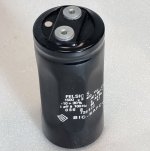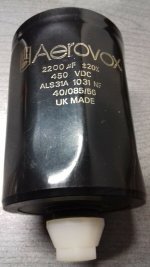Well, I don't know... I've heard a lot about the benefits of oaken (or even hickory - gasp!) enclosures for your coupling capacitors. Those very knowledgeable in such matters have described the resultant sound as "Full and very dense with ear-coating tannins but also attractive fresh fruit, pretty acidity and a long finish. Rather chewy and needs time." Pretty hard to argue against something so compelling as that! 
Sorry, I sometimes get my wine and capacitor reviews mixed up. The same meaningful semantic content confuses me...

Sorry, I sometimes get my wine and capacitor reviews mixed up. The same meaningful semantic content confuses me...
in post 2234 underif you want to get more information in detail, ask there:
Jens Both
Elko-Consulting
Sieker Landstraße 123 b, D-22927 Großhansdorf
Phone: 0049 (0)4102 63757, jens.both@t-online.de
found by the URL
Elko-Consulting
Mr. Both works a long time for Valvo/Philips (development manager, manufacturing electrolytic capacitors).
There are several reports from him regarded caps. search for "Bad Caps".
https://www.diyaudio.com/community/threads/best-electrolytic-capacitors.151392/page-112
I have mentioned, that Mr. Both worked as an advisor for this company from China:
https://www.jianghai.com/enfile/upload/2020/03/25/CD137S.pdf
https://english.jianghai.com/about/aboutHistory_28.html
https://jianghai-europe.com/wp-content/uploads/Jianghai-Europe-Elko-Grundlagen-AAL-2018-09-18.pdf
(go to last page of this pdf for more details concerning older technical papers written by Mr. Jens Both).
Under
https://jianghai-europe.com/capacitor-competence-center/fachartikel/
are several technical papers as PDF available for download written by Dr. Arne Albertsen - both in German and English language.
In the attachment any examples.
I guess, that this brand is also a good choice for new projects, modifications and repair service and similar quality standard as on the brand FTcap is to expect.
Any experiences ?
Attachments
-
Reststromverhalten moderner Elektrolytkondensatoren.pdf782.6 KB · Views: 192
-
Lifetime-Estimation of Electrolytic Caps.pdf287 KB · Views: 120
-
Jianghai-Europe-E-Cap-Reliability-AAL-2018-09-18.pdf481.1 KB · Views: 99
-
Jianghai-Europe-E-Cap-Voltage-Proof-AAL-2018-09-18.pdf578.2 KB · Views: 81
-
Jianghai-Europe-Lebensdauer-zyk-Lastprofile-AAL-2018-09-18-NEU.pdf366.9 KB · Views: 135
-
Technical_Notes for Elcaps.pdf852.7 KB · Views: 115
Last edited:
Hi tiefbassuebertr,
Please don't repost earlier posts.
Anyway, the important aspects may be some of the papers such was posted from Wurth. I'll take a Wurth capacitor over a Philips any day, they made the cheapest stuff going for years.
Have you read and understood any information or papers you posted? If not, read them first to make sure they are useful first.
Please don't repost earlier posts.
Anyway, the important aspects may be some of the papers such was posted from Wurth. I'll take a Wurth capacitor over a Philips any day, they made the cheapest stuff going for years.
Have you read and understood any information or papers you posted? If not, read them first to make sure they are useful first.
Mean you this capacitors ?
https://www.we-online.com/de/components/products/WCAP-AWG8_SCREW
P.S.: I don't ask for Philips caps (already since a long time no longer available) please check out my previous post 2944 more exactly.
the attached PDF concerning failure modes is very interesting
https://www.we-online.com/de/components/products/WCAP-AWG8_SCREW
P.S.: I don't ask for Philips caps (already since a long time no longer available) please check out my previous post 2944 more exactly.
the attached PDF concerning failure modes is very interesting
Attachments
Last edited:
I haven't seen those here, and Philps only had tag type connections from what was carried here.
The normal Philips board mounted capacitors were not very good.. They were used in cheap amplifiers, generally a good place to start replacing things. They were also used in test equipment (Philips scopes) and tended to fail as well.
I don't have time to investigate a ton of links, I need a directed reason to spend the time. I do look at the data sheets for all parts when selecting components, but no way will I remember parts I reject.
The normal Philips board mounted capacitors were not very good.. They were used in cheap amplifiers, generally a good place to start replacing things. They were also used in test equipment (Philips scopes) and tended to fail as well.
I don't have time to investigate a ton of links, I need a directed reason to spend the time. I do look at the data sheets for all parts when selecting components, but no way will I remember parts I reject.
From Würth electronics I have found this APPLICATION NOTE (ANP125) both in English and German language:
Acoustic Effect of Harmonic Distortions caused by Aluminum Electrolytic Capacitors
Acoustic Effect of Harmonic Distortions caused by Aluminum Electrolytic Capacitors
Attachments
Question about elcaps whose cans are crimped with a super-sized crimp tool
My English vocabulary is not sufficient to correctly describe this process during production. Hence the photos in the attachment for comparison.
What is the reason for this additional work step being carried out (go to the first both attachment) ?
And what are the pros and cons of both versions (i. e. with and without this additional process) ?
P.S.: When comparing various electrolytic caps in amplifier power supplies, I often had the impression that designs like those shown in the first two photos always provided the better sonic performance.
From currently production I only find this brand, which offer elcaps as to see in the first both attachment:
https://www.charcroft.com/pdf/manufacturer/sic_safco/felsic-hc-v1.pdf
https://www.charcroft.com/manufacturer/exxelia-sic-safco/
My English vocabulary is not sufficient to correctly describe this process during production. Hence the photos in the attachment for comparison.
What is the reason for this additional work step being carried out (go to the first both attachment) ?
And what are the pros and cons of both versions (i. e. with and without this additional process) ?
P.S.: When comparing various electrolytic caps in amplifier power supplies, I often had the impression that designs like those shown in the first two photos always provided the better sonic performance.
From currently production I only find this brand, which offer elcaps as to see in the first both attachment:
https://www.charcroft.com/pdf/manufacturer/sic_safco/felsic-hc-v1.pdf
https://www.charcroft.com/manufacturer/exxelia-sic-safco/
Attachments
Last edited:
For an audio application, I would look at the audio result and derive audio-relevant actions. One would have to listen to these capacitors before and after crimping.
I would avoid the thick alu sockets. My experience is that these large diameterss are harmful to the sound. You could cut them slightly, which would also improve the sound.
I would avoid the thick alu sockets. My experience is that these large diameterss are harmful to the sound. You could cut them slightly, which would also improve the sound.
It is done for mechanical purposes. With these intentionally applied "dents" the casing is more sturdy/less prone to dents that may happen during transport. The used aluminium is thin and soft. In the round normal form a large dent in such a large sized capacitor is easily made and easily seen too. As they are used with a screwed clamp mounted on a chassis the clamp may hurt the cap. Less so with the dents. The last that is desired is a collapsing casing and a short circuit as result.
It was very long ago but of course destructive testing was done and at least once (Felsic/Sic Safco) I noticed the innards to be kept together by a layer of paper and the casings dents. Possibly they are therefor also less sensitive to vibrations. It is exclusively used on industrial series capacitors for heavy duty use in UPSes etc.
The impression that they sound better may have to do with listening with the eyes 🙂
It was very long ago but of course destructive testing was done and at least once (Felsic/Sic Safco) I noticed the innards to be kept together by a layer of paper and the casings dents. Possibly they are therefor also less sensitive to vibrations. It is exclusively used on industrial series capacitors for heavy duty use in UPSes etc.
The impression that they sound better may have to do with listening with the eyes 🙂
Last edited:
These are sonically by far the best, double can screened. etc, etc.
Just my 2 cents played with BHC Aerovox before, they're dark sounding unless you're using the split foil varieties
Hi Nico Ras,
Wow!
Massively bad idea. No ventilation, very substandard replacement capacitor.
People try this with multisection high voltage cans as well. Horrible idea done by people who lack an understanding of how this stuff works.
Wow!
Massively bad idea. No ventilation, very substandard replacement capacitor.
People try this with multisection high voltage cans as well. Horrible idea done by people who lack an understanding of how this stuff works.
nice😀 old meme still aroundView attachment 1345392
These are sonically by far the best, double can screened. etc, etc.
IMO, re-stuffing should only be done for ascetic reasons and only then in carefully considered circumstances - there is no performance benefit involved. As @anatech said, not to be done in ignorance. The single most damaging effect is to "ovenize" the replacement capacitor and increase the buildup of any heat generated - and elevated temperature is the single most relevant factor in reducing a electrolytic capacitor's lifetime in normal operation. I will beg to differ in that re-stuffing those high voltage capacitors can (and frequently has) been done successfully but only by paying close attention to the power dispersion, clearance requirements, and by generally having an "understanding of how this stuff works."
Hi Hal,
Sure it can and does get done. But they don't last nearly as well.
Since CE Manufacturing makes new ones the same way, use those if you can. Especially since the "recap" jobs I see, they are charging tons doing it the wrong way, and you could get the proper part for the same or nearly the same money. Otherwise if you have the space, use tag strips and axial caps and do it neatly so it will last.
I'll call them "stuff jobs". I've seen some load the can with silicone. Makes things even worse, and try to service that mess. New small sized capacitors do not perform as well as the larger ones (that don't fit). So what does that tell you?
Sure it can and does get done. But they don't last nearly as well.
Since CE Manufacturing makes new ones the same way, use those if you can. Especially since the "recap" jobs I see, they are charging tons doing it the wrong way, and you could get the proper part for the same or nearly the same money. Otherwise if you have the space, use tag strips and axial caps and do it neatly so it will last.
I'll call them "stuff jobs". I've seen some load the can with silicone. Makes things even worse, and try to service that mess. New small sized capacitors do not perform as well as the larger ones (that don't fit). So what does that tell you?
The hemp contributes to the good sound, especially when heatedWe can't always afford polypropylene capacitors, much less
Teflon (tm), so we often make do with electrolytics when
we need those higher values.
There's all sorts of caps out there with claims to being better,
and they certainly are more expensive.
My favorite is the Elna silk capacitors, available from Digikey,
and really cheap. The measure spectacularly, sound great,
and the manufacturer's translated description of why they
sound better is a Babelfish classic.
So before you run out and spend a lot on the highly hyped
spendy caps, try the Elna silk caps.
There's hemp in them, too.
😎
- Home
- Design & Build
- Parts
- Best electrolytic capacitors



